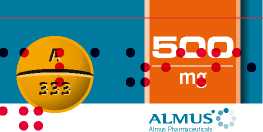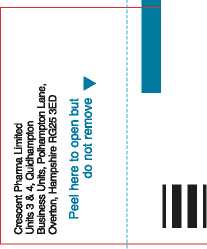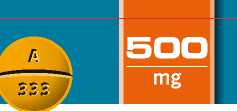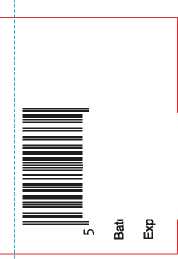Sulfasalazine
Out of date information, search another
• Protect from Beat, light aWd m#sture.
PL Holder: Crescent Pharma Umited, Units 3 & 4, Quidhampton Business Units, Polhampton Lane, Overton, Hampshire, RG25 3ED Almus v is a registered trademark
POM

Sulfaszbzine Tsbbts
• • • Oral use
Each tablet contains Sulfasalazine 500mg PL20416/0156
•F • oral«dmi«strafcn, as Birectarl by the doctor. A0333/9
• BKEEP OUT Oi THE atGBWND REACH OF CHILDREN
If you take too many Sulfasalazine Tablets
If you think you have taken too many tablets, contact your doctor straight away or go to the nearest hospital casualty department. Take with you any remaining tablets and the pack so that the medicine can be identified.
If you forget to take Sulfasalazine Tablets
If you forget to take a dose of this medicine, take it as soon as you remember. However, if it is almost time for the next dose, skip the missed dose and take the next dose at the usual time.
DO NOT TAKE TWO DOSES AT THE SAME TIME.
4. Possible side effects
Like all medicines, Sulfasalazine Tablets can cause side effects, although not everybody gets them.
STOP taking the tablets and contact your doctor IMMEDIATELY if you experience:
• difficulty breathing, wheezing, raised, itchy red lumps (hives) on the skin, swelling of the face, mouth or throat - these may be signs of a severe allergic reaction
• potentially life-threatening skin rashes or blistering of the skin, mouth, eyes or genitals (these may be signs of Stevens-Johnson syndrome or toxic epidermal necrolysis - see Section 2). Frequency: very rare (may affect up to 1 in 10,000 people)
• itching, rash, redness, peeling, increased sensitivity to sunlight or UV light - these may be signs of allergic skin reactions
• generally feeling unwell, fever, joint pain, hives, swollen glands, rash and itching. These may be signs of a condition known as serum sickness.
Contact your doctor IMMEDIATELY if you experience:
• sore throat, fever, severe tiredness, pallor (paleness), unexplained bleeding, bruising easily, generally feeling unwell or difficulty in getting over an infection - these may be signs of a serious blood disorder. If this happens your doctor will stop your treatment while awaiting the results of blood tests.
Tell your doctor, pharmacist or nurse if you suffer from any of the
following other effects:
Very common effects (may happen to more than 1 in 10 people):
• feeling sick, indigestion, heartburn.
Common effects (may happen to more than 1 in 100 people):
• diarrhoea, being sick, abdominal pain, mouth ulcers or swelling in the mouth, change in taste
• headache, dizziness, high temperature, difficulty sleeping
• ringing in the ears, bloodshot eyes
• cough, joint pain, itching, protein in the urine.
Uncommon effects (may happen to more than 1 in 1000 people):
• depression
• fits
• inflammation of blood vessels, often with skin rash
|
• puffiness around the eyes and face • feeling of dizziness or "spinning" • breathlessness • hair loss, hives. The following other effects have been reported: • severe diarrhoea, worsening of the symptoms of ulcerative colitis • hallucinations • aseptic meningitis - symptoms are fever, headache, stiff neck, feeling or being sick and rash |
• other blood disorders including enlarged red blood cells, sore or swollen glands • changes in mental state • inflammation of the heart muscle or the sac surrounding the heart • lung complications with breathlessness • kidney problems including disease or inflammation which can cause swollen ankles/fluid build up in other parts of the body or high blood pressure, and crystals or blood in the urine • hepatitis - symptoms include yellowing of the skin and the whites of the eyes |
• inflammation of the pancreas - symptoms are severe pain in the abdomen and back • allergic condition which causes joint pain, skin rashes and fever • weakness, tingling or numbness • difficulty in controlling movements • low sperm count and infertility in men (returns to normal once treatment is stopped) • bluish tint to the skin • loss of appetite, changes in smell, inflammation of the salivary glands. |
Your urine may become yellow/orange in colour when you are taking Sulfasalazine Tablets, this is normal and nothing to worry about. Reporting of side effects If you get any side effects, talk to your doctor, pharmacist or nurse. This includes any possible side effects not listed in this leaflet. You can also report side effects directly via the Yellow Card Scheme at: www.mhra.gov.uk/yellowcard. By reporting side effects you can help provide more information on the safety of this medicine. |
5. How to store Sulfasalazine Tablets KEEP ALL MEDICINES OUT OF THE SIGHT AND REACH OF CHILDREN. Keep the tablets in the pack provided. Protect from heat, light and moisture. Do not take the tablets if the expiry date on the pack has passed. If you have any medicines that are out of date, return them to your pharmacist for safe disposal. |
6. Further information Ingredients: Each tablet contains 500 mg of Sulfasalazine as the active ingredient. Other ingredients are magnesium stearate, povidone, sodium starch glycolate and iron oxide yellow (E172). What Sulfasalazine Tablets look like: The tablets are round, yellow-brown in colour with company logo on one side and a break-line and "A333" on the other side. They are available in pack size of 28,42,50,56,84,100,112,250,500 and 1000 tablets. Not all pack sizes may be marketed. |
Product Licence Holder and Manufacturer: The Product Licence Holder and Manufacturer is Crescent Pharma Limited, Units 3 &4, Quidhampton Business Units, Polhampton Lane, Overton, Hants, RG25 3ED Date leaflet prepared: February 2015 If you would like this leaflet in a different format, please contact the licence holder at the above address. |
|
PATIENT INFORMATION LEAFLET SULFASALAZINE Tablets 500mg Please read all of this leaflet carefully before you start taking this medicine. Keep the leaflet, you may need to read it again. If you have any questions or are not sure about anything, ask your doctor or pharmacist. This medicine has been prescribed for you. Do not pass it on to others. It may harm them, even if their symptoms are the same as yours. |
If any of the side effects get serious, or if you notice any side effects not listed in this leaflet, please tell your doctor or pharmacist. In this leaflet: 1. What Sulfasalazine Tablets are and what they are used for 2. Before you take Sulfasalazine Tablets 3. How to take Sulfasalazine Tablets 4. Possible side effects 5. How to store Sulfasalazine Tablets 6. Further information |
1. What Sulfasalazine Tablets are and what they are used for Sulfasalazine belongs to a group of medicines called aminosalicylates which reduce inflammation in the bowel. Sulfasalazine Tablets are used in the treatment of ulcerative colitis and Crohn's Disease which are two kinds of inflammatory bowel disease. 2. Before you take Sulfasalazine Tablets Do not take these tablets if: • you are allergic to salicylates (eg. aspirin), to sulfonamide |
antibiotics (eg sulfamethoxazole and trimethoprim), or to any of the ingredients in the tablets which are listed in Section 6 (An allergic reaction may be recognised as shortness of breath, blocked nose, rash, itching, swollen face or lips) •you suffer from porphyria. These tablets should not be taken by children under 2 years of age. Check with your doctor before taking these tablets if: •you have a history of allergies or asthma •you suffer from liver, kidney or blood problems |
• you suffer from a lack of glucose 6-phosphate-dehydrogenase in your body • you are a child and have arthritis. Taking other medicines Sulfasalazine Tablets and other medicines you may be taking may affect how each other work. Make sure your doctor or pharmacist knows if you are taking any other medicines, especially: • anticoagulants (to prevent blood clotting) such as warfarin • medicines for diabetes • phenytoin or hydantoin (for epilepsy) |
• methotrexate (a cancer drug which can also be used to treat psoriasis) • digoxin (for heart failure) • folic acid (usually taken when planning a pregnancy and during the first few months of pregnancy) • phenylbutazone (for treating arthritis) • azathioprine, mercaptopurine, or ciclosporin (to prevent organ rejection after a transplant and for severe inflammatory disease). Other special warnings Potentially life-threatening skin rashes (Stevens-Johnson syndrome, |
toxic epidermal necrolysis) have been reported with the use of sulfasalazine, appearing initially as reddish target-like spots or circular patches often with central blisters on the trunk of the body. Additional signs to look for include ulcers in the mouth, throat, nose, genitals and conjunctivitis (red and swollen eyes). These potentially life-threatening skin rashes are often accompanied by flu-like symptoms. The rash may progress to widespread blistering or peeling of the skin. The highest risk for occurrence of serious skin reactions is within the first weeks of treatment. If you develop a rash or these skin symptoms, stop taking sulfasalazine, seek urgent |
advice from a doctor and tell him that you are taking this medicine. If you have developed Stevens-Johnson syndrome or toxic epidermal necrolysis with the use of sulfasalazine, you must not be re-started on sulfasalazine at any time.
Tests on your liver, kidney and blood Before you start treatment with sulfasalazine you will have a blood and urine test to check how well your kidneys are working and what your blood is doing. During treatment your doctor will check how well your liver, kidney and blood is working by taking blood and urine samples periodically during your treatment.
Pregnancy and breast-feeding
Check with your doctor before taking this medicine if you are pregnant, planning to become pregnant, or you are breast-feeding. You should avoid breast-feeding while taking this medicine. There have been reports of diarrhoea or blood in the stools in infants of breast-feeding mothers taking sulfasalazine.
Driving and using machines:
There are no reports of this medicine affecting your ability to perform skilled tasks such as driving or operating machinery.
3. Howto take Sulfasalazine Tablets
Swallow the tablets with a drink of water.
Always follow your doctor's instructions on how to take your medicine. The pharmacist's label will tell you how many tablets to take and how often to take them. If you do not understand anything, ask your doctor or pharmacist.
Whilst taking this medicine ensure you drink adequate fluids to remain well hydrated, especially after severe or prolonged episodes of vomiting and/or diarrhoea, high fever or heavy sweating. This is to avoid problems with your kidneys.
The usual doses for the following conditions are:
Adults:
Ulcerative colitis:
• Severe/moderate flare-ups: Two to four tablets four times a day, taken in conjunction with a steroid medicine. Do not leave more than 8 hours between the evening dose and the following mornings' dose.
• Mild flare-ups: One to two tablets four times a day, sometimes a steroid medicine may be given, but not always when the attack is milder.
• Maintenance dose: Once the flare-up is controlled your doctor will slowly reduce your dose to one tablet four times a day.
This lower dose may be continued indefinitely to prevent other flare-ups.
Crohn's disease:
Severe/moderate flare-ups: Two to four tablets four times a day, taken in conjunction with a steroid medicine. Do not leave more than 8 hours between the evening dose and the following mornings' dose.
Mild flare-ups: One to two tablets four times a day, sometimes a steroid medicine may be given, but not always when the attack is milder.
Children 2 years of age and over:
Ulcerative colitis and Crohn's disease:
The dose required will be dependent on the child's weight, so it should be taken as directed by the doctor.
Do not stop taking this medicine just because you start to feel better, you may need to continue taking it for some time. When your dose needs to be reduced your doctor will lower the amount you need to take gradually.

112
PL 20416/0156 A0333/9
Tablets Oral use

ATM US’**
Each tablet contains Sulfasalazine 500mg For oral administration, as directed by the doctor. KEEP OUT OF THE SIGHT AND REACH OF CHILDREN
Protect from heat, light and moisture. pQ^
Almus © is a registered trademark

'060057"403334'
Base Label: 40mm x 130mm
Leaflet Page 1: 40mm x 91,5mm Left Hand Opening Z] Overall Leaflet Size: 40 x 1005.5
Text size: 8 pt
Page Widths: 91.5 78 77 76 75 74 74 75 76 77 77 78 77
• • • •• •
• • • • • • •